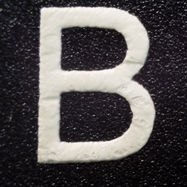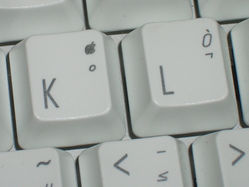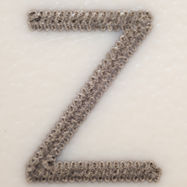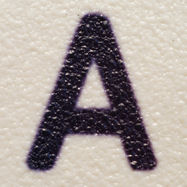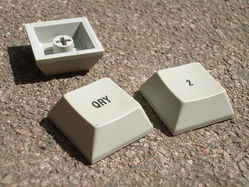Keycap printing
| This article requires additional photographic illustration — need photos of imsto/WASD non-infilled laser engraving |
Over the years, manufacturers of keyboards have devised different methods of marking keycaps with characters. There is no perfect technique, and various trade-offs have to be made.
Contents
Pad printing
Pad printing has been the most popular form of keycap printing since the 1990s, which uses pads dipped into ink to transfer lettering onto the keycaps. Pad printed legends are known for a lack of durability.
Pad printing now accounts for virtually all commercial (office and consumer) legend printing across the world.
Laser marking
Laser marking is the use of a laser beam to mark the legends onto the keycaps. Laser marking works well with straight lines, but has difficulty achieving clean coverage of solid fill areas such as arrowheads. There are numerous ways to alter the colour of plastic using a laser beam, and the terminology varies between manufacturers. In particular, the terms "etching" and "engraving" appear to be interchangeable in terms of which operation they refer to.
Prominent users of laser marking include Apple, Cherry and Matias. The exact processes used by these companies is never described, so some guesswork applies as to which processes are used for the various keyboards and keycap sets on the market.
Charring
Charring, or etching, uses a laser to heat the plastic to the point that it chars to a darker shade. Traditional charred keycaps have pale grey or dark beige legends as a result of the natural colour of the charred plastic. Darker shades may instead be the result of UV-induced photo reduction, or "cold marking", which does not noticeably heat the plastic.
Charred keycaps on a Tactile Pro 3
Foaming
Foaming as a technique is not new, although it is comparatively new to the keyboard industry. Foaming uses a laser beam to create a surface of small, hard bubbles that have a bright appearance, allowing for near-white legends on black plastic. The bubbles have a rough surface that traps dirt, and thereby stains readily. Matias use this technique with the Quiet Pro, and both WASD and QWERkeys offer white-on-black foamed keycaps.
Colouring
Colouring uses the laser beam to burn away one of the plastic colourants, leaving other colourants behind. This allows for limited colour changes. Laser colouring might be the approach taken by Topre with the Realforce, where charcoal keys are coloured to a gold-like beige with a laser beam.
Potentially laser-coloured legends on a Topre Realforce 105UB
Ablation
Ablation, sometimes referred to as engraving, burns deep grooves into the surface of the keycaps. These can be left empty for aesthetic effect, or filled with colourant, termed "infill". Cherry keyboards with black keycaps are laser engraved with white infill, which protrudes above the surface of the keycap. Infill tends to stain quickly.
Ablation may also be the process used in the creation of transparent keys: the transparent plastic is covered in a (usually rubber) coating, and a laser burns off the coating to expose the transparent plastic in the shape of the required character. In this instance, the durability of the material used in the coating is the deciding factor in longevity.
Further reading
- Industrial Laser Solutions — Laser marking plastics
- TRUMPF Laser Technology — Coloring and foaming
- ROFIN — Laser Marking of Plastics
Dye sublimation
Dye sublimation is a process where heat is used to impregnate a material with a dye. This is different to printing in that printing forms a layer of paint on top of the plastic, whereas dye sublimation causes the dye to sink into the plastic. Dye sublimation was a popular method for keycap printing in the 1980s and 1990s. Because the dye permanently stains the plastic, it cannot be worn off like paint, and unlike laser printing, it can be used to easily print a mixture of different colours.
However, in addition to being more expensive than pad printing or laser etching, dye sublimation requires that the dye must be darker than the material it is being used to dye. This means that you cannot use dye sublimation to print white lettering (as nothing is brighter than white) or to print onto black keycaps (as nothing is darker than black). Given the popularity of white-on-black keycaps since the early 2000s, dye sublimation has become non-existent in mainstream keyboards. Today, it is largely confined to Unicomp, who use it to print onto white, grey or coloured keycaps. Topre uses it to print onto white keycaps, but also to print black lettering onto dark grey keycaps.
Prominent users of dye-sublimation include IBM and Unicomp, Apple, and Topre. Acer used dye-sublimated legends on their 6310 series keyboards. Cherry used dye sublimation keycaps on some keyboards of their 3000 series keyboards in the 1990s.
IBM Model M dye-sublimated legends
Double-shot injection molding
Double shot injection molded keycaps (often known as "double shots") are often considered the best type of keycap. Rather than print the legend onto the keycap, the legend is molded from one colour of plastic, and then the remainder of the keycap is molded around it in another colour of plastic. This process has the advantage of producing markings that cannot be worn off, as they are physically part of the keycap. The process also provides high contrast as the legend is not affected by the colour of the surface of the keycap.
Double shot keycaps were de facto standard in the 1970s and early 1980s. However, they are expensive to produce and inflexible (given that a mold is needed for each possible symbol to be printed). Double shot keycaps are typically limited to two colours per keycap; triple or even quadruple shot molded keycaps are possible and have been made, but in most instances, manufacturers used pad printing or dye sublimation for supplemental colours instead of additional moulding stages.
The best-known manufacturer of double-shot keycaps now is Signature Plastics. Other manufacturers include GMK (who now own Cherry's tooling) and Tai-Hao.
Engraving
Engraving follows the same process used to cut custom name badges: the writing is engraved mechanically, and the grooves are inlaid with paint. This time-consuming process is not widely used, being reserved for custom products. Examples of companies providing mechanically engraved keycaps include RAFI and QWERkeys.[1] One disadvantage of this process is that dirt will accumulate in the grooves, which does not wipe clean.
Silkscreen printing
The extent to which silkscreen printing is used, is unclear.
Edgar Matias has indicated that their silkscreen process involves mixing the UV curing substance directly with the paint before application.[2] He also indicate that silkscreen is used in Asia for (presumably) secondary colours on lasered keycaps.
Tai-Hao have confirmed that their TH series keycaps used silkscreen printing in addition to double-shot moulding.
UV printing
"UV printing" is a term used to describe at least two different technologies. UV laser is speculated as a method of printing dark legends on light keycaps, in particular those found on Acer keyboards that appear to be neither pad printed nor dye sublimated. Here, it's suggested that a UV-sensitive substance is first deposited onto the keycap. As this is likely to involve no heating (melting, burning, vaporising) the surface finish of such a process should remain smooth and provide good solid area shading.
In a more general sense, the mixture of a UV-cured substance can apply to silkscreen printing, and may also be part of the non-coated pad printing process.
Colour on white background
QWERkeys use a process that permits printing light colours onto dark keycaps. The colours show dithering suggestive of inkjet printing, and the coloured ink appears to be printed onto a white undercoat. The name appears to derive from the UV-cured lacquer used to seal the printing.
References
- ↑ QWERkeys — Legend Processes
- ↑ geekhack — Keycaps


